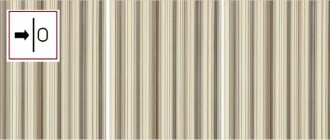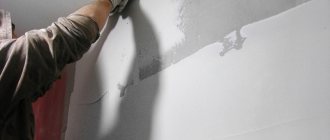- What you need to know "on the shore"
- Determining the height of the wallpaper
- We count the number of wallpaper sheets per room
- We count the number of sheets in a roll
- Final calculation: how many rolls of wallpaper to buy for a room
- Several cheat sheets
- What is important to remember
What you need to know "on the shore"
- Do not “subtract” the area of windows and doors before purchasing wallpaper. It’s better to put these small leftovers aside. With them you will correct errors that may arise during or after work.
- “Subtract” the area of the walls behind the furniture if you are not going to rearrange it. This applies, for example, to large chests of drawers or walls. But keep in mind that the wallpaper should extend behind the furniture on all sides by 10–15 centimeters.
How to calculate a wallpaper pattern with offset
To choose a pattern, you need to know what rapport is. Rapport is a step due to which the pattern is repeated on the wallpaper.
Usually people glue each new sheet of wallpaper “by eye”, and then wonder why it turned out unevenly. Rapport is designed to solve exactly this problem. It must be added to the height of each canvas in order for the design to fit.
The size of the repeat is usually indicated on the wallpaper packaging. The markings are also indicated there. The manufacturer tells you how many centimeters you need to move the wallpaper so that the pattern fits like a glove.
Thanks to repeat and markings, you won't need to try on each sheet. Just trim the amount you need.
Now let's move on to the calculations.
Roll in reserve
Traditionally, it is recommended to take one roll more than the count showed. First of all, it is needed in case of defects at work. There is always a risk of spoiling the canvas - the opening is cut out in the wrong place, it is torn during pasting, it is hopelessly dirty during work, etc. In this case, reserves for window and door openings will not save you.
Secondly, for repairs. This is especially true for children’s rooms, kitchens, entrance areas, passage places where the wall is often touched with hands, and the presence of pets. In some cases it makes sense to completely re-glue the canvas, in others it makes sense to replace a piece. So that the joints are not noticeable and do not reveal the patch, a piece of new dry wallpaper is placed on the problem area and both layers are cut out with a sharp stationery knife, after which the bottom one is removed and a new one is glued in its place. The joints will fit perfectly and will be almost invisible.
For the same reason, it is not recommended to throw away large trimmings after completing repairs.
After spending just 15 minutes reading, you will find out what types of wallpapers there are:
- How to choose wallpaper for your dream bedroom? Selecting the color and type of wallpaper
- Bamboo wallpaper for walls: pros and cons
Determining the height of the wallpaper
The canvas is a piece of wallpaper from top to bottom of the room.
To calculate wallpaper for a room, measure the height of your room. It is usually indicated in the registration certificate of the apartment or house. To be sure, it is better to measure the height on all sides and equal the maximum.
Be sure to add rapport to the height and allowance for cutting the fabric at the top and bottom (about 8–10 centimeters).
Let's give an example
We need to hang wallpaper in a room with a ceiling height of 2.70 m. Wallpaper repeat is 60 centimeters. This means that no displacement is required, but for the margin we will take 10 centimeters.
Now let’s add up these indicators: 270 cm (room height) + 0.60 m (rapport) + 0.10 m (reserve) = 340 cm = 3.40 m = 3 m 40 cm. This is the estimated height of the canvas.
Necessary clarifications on the calculation procedure
Options for selected wallpaper
Modern wallpapers amaze with their variety. They differ in the material used to make the base and front layer - they can be paper, non-woven, vinyl, fiberglass based, made from natural materials (bamboo, cork), or their textiles. Their external design is also presented in a wide range. But in the context of this article, we are mostly interested only in the dimensional parameters and type of applied pattern. Let's start with the sizes.
Standard sizes of wallpaper rolls
First, you need to correctly set the linear dimensions of the wallpaper you like. They must comply with existing standards (with minimal error) - these parameters are usually indicated on product labels on each roll.
Rolls of wallpaper can vary in length and width - this requires attention when choosing material
- It is immediately noticeable that the calculator defaults to wallpaper, a roll of which measures 53 × 1005 cm or 0.53 × 10.05 m (note: the length is not 10 and a half meters, but precisely 10 meters + 5 centimeters - this is very common permissible error when performing calculations).
Indeed, this standard is the most common. It is believed that it is precisely such narrow canvases that are most convenient for beginning finishers to work with. In this size range you can find any type of finish.
vinyl wallpapers
- The next most diverse variety of options presented is the standard 106 × 1005 cm. Essentially, this is the same wallpaper, but doubled in width. It is clear that pasting the wall in this case is faster, but working with wide canvases will require more practical skills. However, many craftsmen claim that it is easier for them to complete finishing with such a wide standard.
- Imported wallpaper with a width of 74 cm is quite common. The length of the roll in this case is usually 10 m.
- Wallpaper with a width of 60 cm, 120 cm, 150 cm is very rare, but such standards still exist, so the calculator also pays attention to them.
- In addition, wallpaper can vary in thickness - from super-thick with a vinyl relief pattern to thin non-woven or fiberglass - for painting. Accordingly, variation in the length of the roll is not excluded, while maintaining its standard width. So, on sale you can find, in addition to the mentioned 10.05 m, rolls 5, 8, 12, 15, 18, 20 and 25 meters long. This variety is also provided in the calculator.
Type of pattern and size of repeat
It would seem that everything is simple: there is a standard roll length, wall height, and it is easy to determine how many canvases will be made from each roll. But it is not so.
Firstly , the correct technology for decorating walls with wallpaper assumes that the canvas is cut with a mandatory allowance at the top and bottom, which, after gluing, is carefully cut with a sharp knife along the baseboards (floor and ceiling) or along the intended line. This means that at least 50 mm must be added to the length of each blade.
Wallpaper must be glued with an allowance at the top and bottom, which is then cut along an even line with a sharp knife
Secondly , another parameter intervenes in the calculation process - the type of pattern and the need to combine it. There may be various options here.
- Wallpaper design does not require matching the pattern.
A pictogram indicating that pattern matching is not required.
This is the simplest option - the canvas can be cut from any point on the roll, that is, there are no small scraps left. A typical example is vertical lines, any shapeless stains, toning or relief of a chaotic order, etc.
wallpaper
This pattern does not require adjustment
Check out the theory, practice and calculation of how to glue glass wallpaper for painting from a new article on our portal.
- An infrequently encountered variety is wallpaper, each sheet of which, when pasted, must take the opposite direction.
Wallpaper with reverse gluing
This wallpaper usually has vertical lines, and the need for reverse is determined only by the location of the stripes.
Each subsequent canvas is turned over, but adjustment of the pattern is still not required
You can also cut such canvases from any point.
- A more complex case is when the details of the drawing require mandatory alignment. But in this case, shifting the canvases is not required, since the pattern is oriented horizontally.
The drawing requires alignment, but without vertical displacement.
The height (step) of the drawing has its own name - rapport. So, when cutting such rolls, it is possible that in order to mark the beginning of the next web, you will have to remove a strip close to the size of the repeat from the scraps. Naturally, this may affect the number of whole canvases from one roll.
An example of joining a pattern that does not require vertical displacement
At the same time, each of the canvases begins from approximately the same point, attached to the drawing.
- Finally, another option - the pattern also requires adjustment, but due to its diagonal location, each successive canvas is shifted vertically by a certain amount (usually half the repeat).
Pictogram on wallpaper with an offset pattern
Very often, novice craftsmen make the most mistakes with this kind of wallpaper.
The blades are cut with an offset of ½ repeat
It is clear that even with such cutting, almost an entire rapport can be wasted into scraps if the outcome is unfavorable.
On product labels of wallpaper that require pattern matching, there is usually a pictogram indicating the repeat (in the numerator) and the amount of pattern shift (in the denominator).
Icon with the values of repeat and vertical shift of the pattern
So, in order to be sure not to make a mistake with the amount of wallpaper, the length of the roll when determining the number of finished canvases must be divided not only by the height of the wall, but also taking into account the allowance (min. 50 mm) and repeat.
Basic parameters of the room
The main parameters of the room for calculations will be the perimeter and height. A few words in more detail.
- It’s not difficult to measure the perimeter, for example, by walking along the walls with a tape measure. The easiest way is in a rectangular room. It’s a bit more complicated – in a room of irregular shape, but it shouldn’t cause any particular difficulties either. If there are niches or ledges in the room that will also be covered with wallpaper, then their perimeter must be taken into account.
The entire perimeter is entered into the calculator (or the full length of the wall to be covered with wallpaper, if a variety of finishes are intended).
- An important point: windows and doors - should they be taken into account when determining the amount of wallpaper?
This requires an individual approach. Agree that a door can be only 600 - 800 mm wide, and then when calculating it can simply be “not noticed” and mistaken for a flat wall.
Clearly, there cannot be a single approach to such different doors (and similarly to windows)
But the door can be two- or even three-leaf, one and a half meters wide or more - it probably makes sense to exclude such an opening from the calculations. The situation is similar with windows. In this option, the width of window and door openings can be subtracted from the perimeter of the room - the remaining scraps and the created reserve are usually more than enough to seal the areas above the doors, above and below the windows. This is especially true for wallpaper with a combination of patterns - when cutting, very long sheets are often left.
Wallpaper for painting
- And the last parameter is height. The concept of “ceiling height in a room” often appears in instructional articles. This seems not entirely correct - skirting boards are often placed above and below the wall, which “eat up” a certain height. In addition, wallpaper may not be applied to the entire wall, for example, when complex finishing is done with various materials (or even several types of wallpaper). It would probably be more correct to use the concept of the height of the wall section being pasted over. It is entered into the calculator in its “pure form” - without adding any allowances or offsets to fit the pattern.
Find out how to glue vinyl wallpaper, and also learn how to decorate a room yourself, from a new article on our portal.
Now you can, with all the knowledge of the matter, proceed directly to the calculations. But one more small addition: it is recommended to always purchase at least one roll in reserve - situations vary. This is also taken into account in our calculator.
And finally, to help the novice master - a short video with tips on choosing wallpaper:
We count the number of wallpaper sheets per room
First you need to look at the packaging for the width of the roll. There are standard wallpapers with a width of 53 centimeters (a little wider for painting), and there are so-called meter wallpapers with a width of 1.06 meters.
For example, let’s take wallpaper with a standard width of 53 centimeters. Now we measure the perimeter of the room in which you need to wallpaper (add two lengths and two widths). We got 16 meters.
Now the following formula: 16 m (perimeter) ÷ 0.53 m (wallpaper width) = 30.1. We round up and get 31 canvases for the room.
How to find out how many square meters
To determine the required number of canvases, it is necessary to calculate the total area of the canvas and the room in which the repairs are to be made. Based on the results obtained, it is worth calculating the number of wallpapers.
The easiest way to do it is this way:
- the area of each individual wall is calculated (height multiplied by width);
- the resulting numbers are summed up.
Experts advise that when taking measurements, windows and doors should also be taken into account; they should not be removed from the calculation. A supply of material will never be superfluous.
We count the number of sheets in a roll
To calculate the number of sheets, look at the length of the roll, which is indicated on the packaging. Usually it is 10.05 meters, but it can be more or less. The length indicated on the package must be divided by the height of the canvas, which we obtained in the first example, and the final amount must be rounded down.
Counting example
1005 cm (roll length) ÷ 340 cm (sheet height) = 2.95 sheets.
This means that there will be only two canvases in one roll. Unfortunately, we don’t reach the third. You can count this as three canvases if you have high baseboards at the bottom or glue a special strip on top.
Professional advice on calculating wallpaper rolls
- Take a close look at the wallpaper that does not have repeat, if it is not completely monochromatic. Even slight variegation or barely noticeable geometry of the pattern may require a shift to level out the joints and provide better visual perception.
- Do not expect to buy the missing wallpaper later, even if the selected model is on sale in abundance. It is unlikely that they will be from the same batch, and different batches may differ noticeably in shade.
- Take into account the possible curvature of the walls, which will require moving the panels horizontally.
- For larger rooms, it is recommended to purchase one additional roll for every six calculated.
- Lastly, places that are hidden from view and do not require full-length stripes are pasted over - above windows, doors, in niches, etc. If there is an unexpected shortage, they can be pasted over in pieces or a roll from another batch.
Sometimes small details spoil a big plan, so when calculating the required quantity, you should not save time and attention to take into account all the described subtleties. Need wallpapering? Entrust your repairs to the professionals from Nikon Stroy!
Final calculation: how many rolls of wallpaper to buy for a room
To calculate how much wallpaper you need, do the following. We divide the required number of canvases by the number of canvases in a roll of wallpaper, which we got in the previous example.
Below we give two examples: with two and three canvases per roll.
It is advisable to add another roll of wallpaper in reserve. It will help out in two cases: in case of possible defects or when repairing old wallpaper after dirt or fading in “strategic” places.
Formula and table for calculating wallpaper
If we are talking about a standard rectangular or square room, a special table comes to the aid of repairmen. It provides information on the number of rolls needed for finishing, and there are separate information stands for wide and narrow trellises.
To take advantage of the help offered, it is enough to know the area of the room and the height of the ceilings. The amount of wallpaper required for repair can be seen at the intersection of the corresponding row and column of the table.
With the help of modern service applications, calculating the number of trellises required for repair is quite simple.
Don’t worry if after the repair there are 1-2 extra rolls and large scraps left.
Professional repairers recommend saving this product - it may be useful in case of replacing worn out or stained fragments.
Wallpapering
Several cheat sheets
Below are several tables for calculating the number of wallpapers.
Width 63 centimeters and length 10 meters
Width 70 centimeters and length 10 meters
Width 106 centimeters and length 10 meters
What is important to remember
- It is advisable to also consider the area of windows and doors as walls in order to leave some of the wallpaper in reserve. They will be useful for sealing possible irregularities.
- When you are choosing wallpaper for a room, also stock up on an extra roll. It will help with defects in the canvas and for repairing wallpaper.
- When determining the height, add 8–10 centimeters to the wallpaper.
- Be sure to consider rapport. He will help you choose the right pattern. The repeat size is always indicated on the packaging.
- Don't save too much on wallpaper. Your model may run out in the store, and if there is a shortage, you will not buy the required quantity.
Is it possible to return excess wallpaper to the store?
Article 25 Article 25. The consumer’s right to exchange goods of proper quality under the “Law on the Protection of Consumer Rights” provides for the return of all purchased goods if they do not match the style or color. And subject to a number of conditions.
- Wallpaper was sold in rolls, not by the meter. The list of NON-FOOD PRODUCTS OF GOOD QUALITY, NOT SUBJECT TO RETURN OR EXCHANGE FOR A SIMILAR GOODS OF OTHER SIZE, SHAPE, SIZE, STYLE, COLOR OR EQUIPMENT of non-food products of proper quality, not subject to return or exchange, includes finishing materials. But we are talking only about goods sold by the meter.
- The wallpaper remained unopened, not wrinkled or scratched.
- No more than 14 days have passed since the date of purchase. When purchasing online – 7 days.
- There is a receipt or other document confirming the fact of purchase. If the receipt has not been saved, you can request a cash register tape (stores keep it for a month) or attract witnesses.
In other words, if you don't like the wallpaper, you can take it back to the store. All rolls. In this case, the seller will offer you a similar product, and if there is none, you can write a request for a refund.
Returning one or two extra rolls after repair will be problematic. But large stores usually accommodate customers halfway. After all, they purchase wallpaper in large quantities, and plus or minus one roll does not particularly affect sales. Customer loyalty is more valuable.
Just in case, check the return policy before purchasing.











